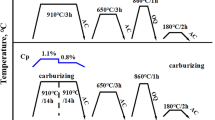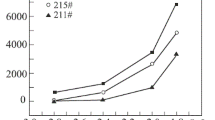Abstract
The bending fatigue behavior of two carburized steels is investigated for lives between approximately 105 and 108 cycles. Cracks are observed to start at sub-surface inclusions and develop features on fracture surfaces resembling “fish eyes” in appearance. This type of sub-surface cracking tends to govern fatigue strength at long lives. Previous studies of “fish eye” fatigue in carburized steel have been relatively few and have mainly considered failures originating at depths beneath a carburized case, where compressive residual stresses are minimal and hardness values approach those in the core. This study provides fatigue data for cracks originating within cases at various depths where compressive residual stresses are substantial and hardness is much higher than in the core. Fatigue strength is predicted by a simple model, accounting for the influence of residual stresses and hardness values at the different depths at which cracks started. Predictions of fatigue strength are compared with data generated in this study.











Similar content being viewed by others
References
Y. Murakami, Metal Fatigue: Effects of Small Defects and Nonmetallic Inclusions, Elsevier Science Ltd., Oxford, 2002
M. Capetti, T. Tagawa, and T. Miyata, Ultra-long Cycle Fatigue of High-Strength Carbon Steels Part I: Review and Analysis of the Mechanism of Failure, Mater. Sci. Eng., A, 2013, 356, p 227-235
T. Sakai, Review and Prospects for Current Studies on Very High Cycle Fatigue of Metallic Materials for Machine Structural Use, J. Solid Mech. Mater. Eng., 2009, 3, p 425-439
X. Li, Effects of Inclusions on Very High Cycle Fatigue Properties of High Strength Steels, Int. Mater. Rev., 2012, 57, p 92-114
C. Bathias, Gigacycle Fatigue of Bearing Steels, Mater. Sci. Technol., 2012, 28, p 27-33
Y. Murakami, Material Defects as the Basis of Fatigue Design, Int. J. Fatigue, 2012, 41, p 2-10
K. Shiozawa, L. Lu, and S. Ishihara, S-N Curve Characteristics and Subsurface Crack Initiation Behavior in Ultra-long Life Fatigue of a High Carbon Steel-Chromium Bearing Steel, Fatigue Fract. Eng. Mater. Struct., 2001, 24, p 781-790
Y. Ochi, T. Matsumura, K. Masaki, and S. Yoshida, High Cycle Rotating Bending Fatigue Property in Very Long-life Regime of High-cycle Strength Steels, Fatigue Fract. Eng. Mater. Struct., 2002, 25, p 823-830
K. Shiozawa, Y. Morii, S. Nishino, and L. Lu, Subsurface Crack Initiation and Propagation Mechanism in High-Strength Steel in a Very High Cycle Fatigue Regime, Int. J. Fatigue, 2006, 28, p 1521-1532
M. Nakajima, N. Kamiya, H. Itoga, K. Tokaji, and H. Ko, Experimental Estimation of Crack Initiation Lives and Fatigue Limit in Subsurface Fracture of High Carbon Steel, Int. J. Fatigue, 2006, 28, p 1540-1546
Z. Huang, D. Wagner, Q. Wang, and C. Bathias, Effect of Carburizing Treatment on the “Fish Eye” Crack Growth for a Low Alloyed Chromium Steel in Very High Cycle Fatigue, Mater. Sci. Eng., A, 2013, 559, p 790-797
Y. Murakami, T. Nomoto, T. Ueda, and Y. Murakami, On the Mechanism of Fatigue Failure in the Superlong Life Regime (N > 107 Cycles). Part I: Influence of Hydrogen Trapped by Inclusions, Fatigue Fract. Eng. Mater. Struct., 2000, 23, p 893-902
K. Funatani and F. Noda, The Influence of Residual Stress on the Fatigue Strength of Carburized Hardened Steel, J. Soc. Mater. Sci. Jpn., 1968, 17, p 1124-1128
T. Naito, H. Udea, and M. Kikuchi, Fatigue Behavior of Carburized Steel with Internal Oxides and Nonmartensitic Microstructure near the Surface, Metall. Trans. A, 1984, 15A, p 1431-1436
Y. Murakami, T. Nomoto, and T. Ueda, Factors Influencing the Mechanism of Superlong Fatigue Failure in Steels, Fatigue Fract. Eng. Mater. Struct., 1999, 22, p 581-590
Z. Huang, W. Du, D. Wagner, and C. Bathias, Relation Between the Mechanical Behavior of a High Strength Steel and the Microstructure in Gigacycle Fatigue, Mater. Sci. Forum, 2010, 636-637, p 1459-1466
“Standard Test Method for Determining Average Grain Size,” E112, Annual Book of ASTM Standards, vol. 3.01, ASTM, 2012
“Standard Test Method for Knoop and Vickers Hardness of Materials,” E394, Annual Book of ASTM Standards, vol. 3.01, ASTM, 2011
M. Moore and W. Evans, Mathematical Corrections for Stress in Removed Layers in X-ray Diffraction Residual Stress Analysis, SAE Trans., 1958, 66, p 340-345
G. Parrish, Carburizing: Microstructures and Properties, ASM International, Materials Park, OH, 1999
K. Inoue, H. Sonoda, G. Deng, M. Yamanaka, and M. Kato, Effects of CBN Grinding on the Bending Fatigue Strength of Carburized Gears, J. Mech. Des., 1989, 120, p 606-611
R. Pedersen and S. Rice, Case Crushing of Carburized and Hardened Gears, Technical Paper 610034, SAE International, Warrendale, PA, 1961
R. McClung, A Literature Survey on the Stability and Significance of Residual Stresses During Fatigue, Fatigue Fract. Eng. Mater. Struct., 2007, 30, p 173-205
S. Nishijima and K. Kanazawa, Stepwise S-N Curve and Fish-Eye Failure in Gigacycle Fatigue, Fatigue Fract. Eng. Mater. Struct., 1999, 22, p 601-607
T. Sakai, Y. Sato, and N. Oguma, Characteristic S-N Properties of High Carbon-Chromium Bearing Steel under Axial Loading in Long Life Fatigue, Fatigue Fract. Eng. Mater. Struct., 2002, 25, p 765-773
Y. Shimatani, K. Shiozawa, T. Nakada, and T. Yoshimoto, Effect of Surface Residual Stress and Inclusion Size on Fatigue Failure Mode of Matrix HSS in Very High Cycle Regime, Procedia Eng., 2010, 2, p 873-882
K. Shiozawa, T. Hasegawa, Y. Kashiwagi, and L. Lu, Very High Cycle Fatigue Properties of a Bearing Steel under Axial Loading Condition, Int. J. Fatigue, 2009, 31, p 880-888
G. Qian, Y. Hong, and C. Zhou, Investigation of High Cycle and Very High Cycle Fatigue Behavior for a Structural Steel with Smooth and Notched Specimens, Eng. Fail. Anal., 2010, 17, p 1517-1525
W. Hui, Y. Nie, H. Dong, Y. Weng, and C. Wang, High-Cycle Fatigue Fracture Behavior of Ultrahigh Strength Steels, J. Mater. Sci. Technol., 2008, 24, p 787-792
Z. Lei, A. Zhao, J. Xie, C. Sun, and Y. Hong, Very High Cycle Fatigue of GCr15 Steel with Smooth and Hole Defect Specimens, Theor. Appl. Mech. Lett., 2012, doi:10.1063/2.1203103
W. Li, T. Sakai, Q. Li, L. Lu, and P. Wang, Reliability Evaluation on Very High Cycle Fatigue Property of GCr15 Bearing Steel, Int. J. Fatigue, 2010, 32, p 1096-1107
K. Tanaka and Y. Akiniwa, Fatigue Crack Propagation Behavior Derived from S-N Data in Very High Cycle Regime, Fatigue Fract. Eng. Mater. Struct., 2002, 25, p 775-784
J. Zhang, K. Shiozawa, T. Lu, W. Li, and W. Zhang, Fatigue Fracture Behavior of Bearing Steel GCr15 in Very High Cycle Regime, Adv. Mater. Res., 2008, 44-46, p 119-126
Y. Hong, Z. Lei, C. Sun, and A. Zhao, Propensities of Crack Interior Initiation and Early Growth for Very-High-Cycle Fatigue of High Strength Steels, Int. J. Fatigue, 2013, doi:10.1016/j.ijfatigue.2013.02.023
Y. Akiniwa, N. Miyamoto, H. Tsuru, and K. Tanaka, Notch Effect on Fatigue Strength Reduction of Bearing Steel in the Very High Cycle Regime, Int. J. Fatigue, 2006, 28, p 1555-1565
C. Sun, J. Xie, A. Zhao, Z. Lei, and Y. Hong, A Cumulative Damage Model for Fatigue Life Estimation of High-Strength Steels in High-Cycle and Very-High-Cycle Fatigue, Fatigue Fract. Eng. Mater. Struct., 2012, 35, p 638-647
Y. Liu, Z. Yang, Y. Li, S. Chen, S. Li, W. Hui, and Y. Weng, On the Formation of GBF of High-Strength Steel in the Very High Cycle Fatigue Regime, Mater. Sci. Eng., A, 2008, 497, p 408-415
T. Otsuka, H. Hanada, H. Nakashima, K. Sakamoto, M. Hayakawa, K. Hashizume, and M. Sugisaki, Observation of Hydrogen Distribution around Non-Metallic Inclusions in Steels with Tritium Microautoradiography, Fusion Sci. Technol., 2005, 48, p 708-711
K. Shiozawa and L. Lu, Internal Fatigue Failure Mechanism of High Strength Steels in Gigacycle Regime, Key Eng. Mater., 2008, 378-379, p 65-80
P. Novak, R. Yuan, B. Somerday, P. Sofronis, R. Ritchie, and A. Statistical, Physical-based, Micro-Mechanical Model of Hydrogen-Induced Intergranular Fracture of Steel, J. Mech. Phys. Solids, 2010, 58, p 206-228
P. Grad, B. Reuscher, A. Brodyanski, M. Kopnarski, and E. Kerscher, Mechanisms of Fatigue Crack Initiation and Propagation in the Very High Cycle Fatigue Regime of High Strength Steels, Scr. Mater., 2012, 67, p 838-841
H. Streng, C. Razim, and J. Grosch, Diffusion of Hydrogen during Carburization and Tempering, Heat Treatment and Surface Engineering, New Technology and Practical Applications, G. Krauss, Ed., ASM International, Chicago, 1988, p 313-317
Y. Li, Z. Yang, Y. Liu, S. Li, G. Li, W. Hui, and Y. Weng, The Influence of Hydrogen on Very High Cycle Fatigue Properties of High Strength Spring Steel, Mater. Sci. Eng., A, 2008, 489, p 373-379
Y. Li, S. Chen, Y. Liu, Z. Yang, S. Li, W. Hui, and Y. Weng, The Characteristics of Granular-Bright Facet in Hydrogen Pre-Charged and Uncharged High Strength Steels in the Very High Cycle Fatigue Regime, J. Mater. Sci., 2010, 45, p 831-841
Y. Murakami and H. Matsunaga, The Effect of Hydrogen on Fatigue Properties of Steels Used for Fuel Cell System, Int. J. Fatigue, 2006, 28, p 1509-1520
Acknowledgments
We would like to acknowledge Technology for Energy Corp. for providing x-ray diffraction data and Anamet Labs for hardness measurements.
Author information
Authors and Affiliations
Corresponding author
Rights and permissions
About this article
Cite this article
Nelson, D.V., Long, Z. Bending Fatigue of Carburized Steel at Very Long Lives. J. of Materi Eng and Perform 25, 220–226 (2016). https://doi.org/10.1007/s11665-015-1811-8
Received:
Revised:
Published:
Issue Date:
DOI: https://doi.org/10.1007/s11665-015-1811-8




